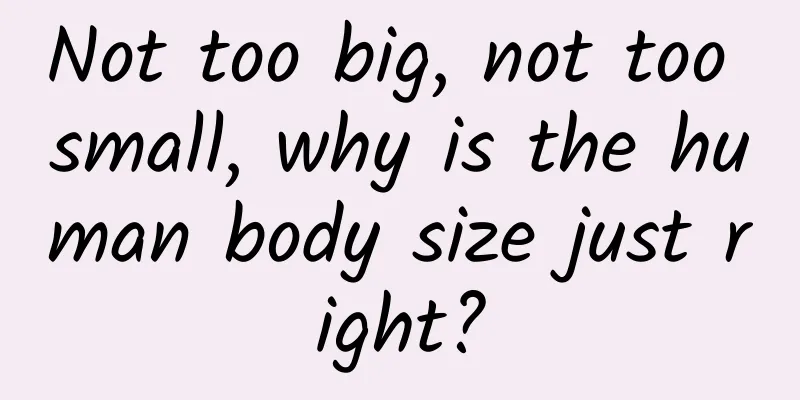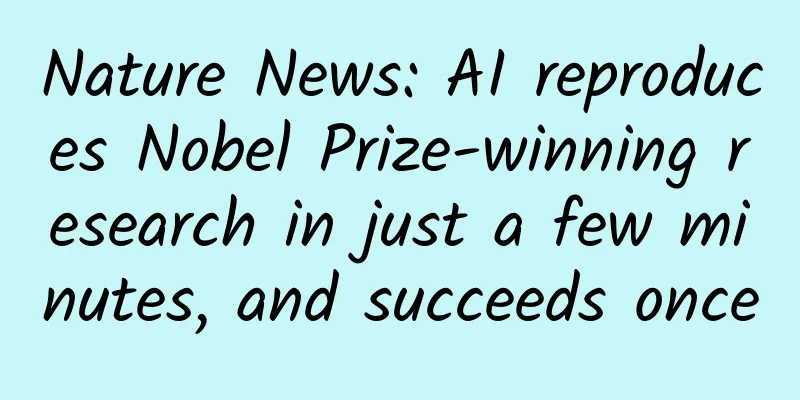Not too big, not too small, why is the human body size just right?

|
In this world, although everyone's height and weight are different, there is always a range of limits. As the saying goes, "No matter how fat you are, you can't be an elephant, and no matter how small you are, you can't be an ant." So we can't help but ask, why are humans neither too big nor too small, but just this tall and this heavy? In the world of animals with different body sizes, what is the "reasonable" size of humans? Written by | Wang Xinkai The body sizes of animals in nature vary greatly, from tiny mice to huge elephants. This diversity makes it difficult for scientists to find a unified rule or compare which is better. On the other hand, the body sizes of modern humans and extinct "ancient humans" are also different. For example, the Australopithecus more than three million years ago weighed about 30 kilograms, while the Homo erectus two million years ago weighed about 80 kilograms. Since animals of all sizes can exist, and human size has not remained constant throughout human evolution, why are modern humans the size they are today? What is the rationale for this? Previous studies have shown that the running speed and endurance of animals may be an important factor in the evolution of species. Therefore, scientists speculate that changes in human body size during evolution may have an important impact on our athletic ability, especially running ability. And our current body size, which is neither too big nor too small, may be the most "perfect" size for sports. There is another phenomenon worth noting: among the many animals in nature, the fastest animals are neither the largest nor the smallest, but often those of medium size. For example, the fastest land animal is the cheetah, which can reach a maximum speed of 104 kilometers per hour; the fastest animals in the water are the yellowfin tuna and squid, which can reach speeds of 75 kilometers per hour and 77 kilometers per hour respectively. Picture: Cheetah running on the grasslands of Kenya | Source: britannica.com This is not just an interesting observation; it actually involves a complex relationship between an animal's body size, movement patterns, and energy expenditure, and is a key to explaining the mystery of human body size. To unravel the mystery, a scientific team from the University of Queensland in Australia used computer simulations to explore the complex relationship between human speed, body shape and biomechanics, and how these factors shaped the body shape of modern humans. The relevant research results were published in the recent journal Nature Communications. Generally speaking, as animals grow in size, some of their biological characteristics and functions will also change. For example, animals with long legs run faster, but this is not absolute, and not all animals with particularly long legs can run particularly fast. In order to find out the influence of different body shapes on human movement and the connection between the two, the research team used a virtual human model including all bones, muscles and tendons. This is a musculoskeletal simulation technology based on physical principles. It no longer relies on real experimental data, but can simulate and predict various virtual movement patterns based on the basic physical principles of the musculoskeletal system. This virtual human model is especially useful for studying animal groups with large body size differences, because it is difficult to find animal groups with such a large body size span for comparison in reality. In this study, the research team explored the effects of human limb movement, muscle strength and energy consumption on the maximum movement speed when the human body size varies from 0.1 kg to 2000 kg. Or to put it bluntly, how fast can humans run when they are reduced to the size of a mouse or enlarged to the size of an elephant. Image: Elephant | Source: Pixabay To this end, they created a series of 3D computer models of the human musculoskeletal system ranging from 0.1 kg to 2000 kg, and adjusted the musculoskeletal properties in each model to conform to the principle of geometric similarity. Then, the research team simulated walking and running at different gait speeds in these models, and observed how the maximum speed and energy consumption of the human body changed within the range of 0.1 kg to 2000 kg. An interesting thing happened. First, according to the current human body shape, when a person weighs 2,000 kg, he or she will be completely unable to move, even if he or she weighs 1,000 kg. In fact, the maximum body weight that a human being can bear while moving with a bipedal gait may be 900 kg. If the weight exceeds this, humans may need to change the structure of bipedal upright walking in order to move. Second, the researchers found that the energetic cost of locomotion (the amount of energy required to move a certain distance) decreases with increasing body size, meaning that larger animals require less energy per unit of body weight to move the same distance. So why are large animals not able to run fast? The results of the simulation experiment show that this may be because their muscles are not strong enough. For large animals, their muscles need to generate greater force to support their weight, but the cross-sectional area of the muscles cannot grow as fast as the weight, resulting in their muscles being relatively weak. Why can't small animals run fast? In fact, for small animals, although their muscles are relatively strong, they are too light. When they try to push off the ground with greater force, it will only make their bodies leave the ground earlier, a bit like a car tire "skidding". This is why larger animals tend to move in an upright position, while smaller animals need to crouch (like a mouse or cat crouching on the ground) to increase thrust and increase contact with the ground, but crouching slows down their steps, affecting their speed. Therefore, between large and small body sizes, there is a medium body size. This perfect body size can well balance the conflict between muscle strength and ground reaction force. The results also show that there is indeed an optimal body shape that allows animals to run at the fastest speed. Under this optimal body shape, animals can find the best balance between maintaining muscle strength and ground reaction force. In order to find the optimal body shape for humans, the researchers designed 30 different models ranging from 0.1 kg to 900 kg to further test the relationship between speed and body shape. The results showed that there is a curvilinear relationship between the maximum running speed of humans and body shape. Among them, the 60 kg model ran the fastest, with a stable running speed of 6.3 meters per second. By statistically fitting the data of all body shapes, the researchers estimated that the optimal body shape that can best increase speed corresponds to a weight of approximately 47 kg. The results of this simulation experiment are also very close to the weight of the optimal speed body shape found in quadrupeds in nature (such as the optimal speed weight of cheetahs). Figure: The relationship between body size and speed of four-legged mammals and different human simulations, showing that medium-sized animals (such as cheetahs) are usually the fastest | Source: Nature Communications As mentioned above, the Australopithecus 3.5 million years ago weighed about 30 kg, the Homo erectus 2 million years ago weighed about 80 kg, the Naledi Homo 300,000 years ago weighed about 37 kg, the Flores Homo 50,000 years ago weighed about 27 kg, and the average weight of modern adult humans is about 62 kg. Body size may have, to some extent, also affected the evolutionary fate of our ancient ancestors and close relatives. Although the body size of modern adult humans is slightly heavier than the 47 kg optimal body size found by the research model, it is still close to the ideal value. Interestingly, many excellent long-distance runners among humans today (such as Kenyan male marathon runner Eliud Kipchoge) weigh exactly about 50 kg. Therefore, based on this new research, scientists believe that humans' current speed is the fastest we can achieve (unless our muscles and morphology undergo major changes), and the body size of modern humans may be the optimal body size for us to achieve maximum running speed. The researchers also said that their findings not only reveal the complex relationship between human body size, speed and energy consumption, but also point out why a certain medium-sized animal can reach the fastest speed. This research result is not only of great significance to the fields of sports science and biomechanics, but also provides new clues for understanding our own evolutionary process, including how humans may better understand how to adapt to different environments and lifestyles, and how to improve movement speed by changing training and exercise strategies. Special Tips 1. Go to the "Featured Column" at the bottom of the menu of the "Fanpu" WeChat public account to read a series of popular science articles on different topics. 2. Fanpu provides a function to search articles by month. Follow the official account and reply with the four-digit year + month, such as "1903", to get the article index for March 2019, and so on. Copyright statement: Personal forwarding is welcome. Any form of media or organization is not allowed to reprint or excerpt without authorization. For reprint authorization, please contact the backstage of the "Fanpu" WeChat public account. |
>>: Take a photo! Tonight, Mars and the Moon will be in the same frame!
Recommend
This lizard, named after the snake monster, has the ability to walk on water.
In the martial arts novel The Legend of the Condo...
What amazing skills do sea snails, known as “global travelers,” have?
Author: Liu Yi Source: Knowledge is Power Magazin...
Luzhou Mini Program Franchise Company, how much does it cost to join a learning mini program?
What is the price to join the Luzhou Learning Min...
Does ice cream "freeze" your child's brain? Let's talk about "ice cream headache"
This is the 3883rd article of Da Yi Xiao Hu Summe...
How to systematically design online and offline brand activities?
Different from daily operational activities, offl...
QUICK FactSet: Tesla's net profit per vehicle reached 50,000 yuan, ranking first among global automakers
A media outlet studied the profits of the world&#...
Haima Automobile's sales target for 2018 has only been achieved by 37.5%
The latest sales data released by Haima Automobil...
What is Geely’s plan behind its intensive deployment of new energy vehicles?
As cars are becoming more common in every househo...
Google SEO Google search skills, how to use Google to search for information?
Recently, many friends have asked me if I know ho...
Weird open source component: Play the "Brick Breaker" game in the pull-down refresh
That’s right, now you can play Breakout while you...
Detailed explanation of Android system Binder
[[422252]] This article is reprinted from the WeC...
The Chinese dragon once had wings
"Cloud Dragon", by Chen Rong, Song Dyna...
Brand Pyramid: A Basic Path to Building a Brand
Written at the beginning: How to build a brand? T...
There is no doubt that iPhone X will stir up a wave of facial recognition in the market
Compared to the uninspired iPhone 8, the iPhone X...









